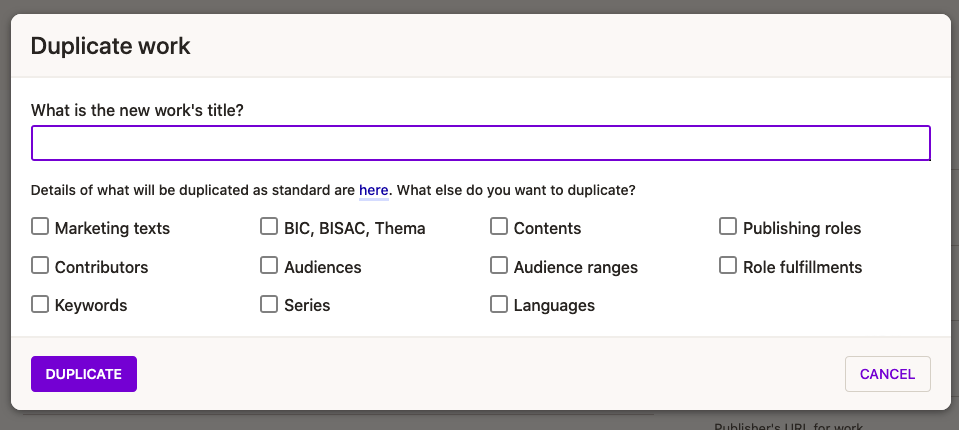This is particularly valuable when you have a new work to create that is almost the same as an existing work. If the work you want to add is not similar or closely related to an existing work, then it is probably better to create a work from scratch.
For example, if you produce an annual publication Guide to Motor Vehicles
which you re-issue every year, it is likely that the majority of metadata is going to be almost the same when you create a new work.
What will get duplicated?
Refine what is to be duplicated by selecting the checkboxes when you click Duplicate work
.

In the absence of any selections or a new title, here is what will be duplicated.
The work’s title metadata:
- Title (the existing title will be prefixed with
Duplicated from
) - Subtitle
- Title acronym
- Alternative titles
- Title (the existing title will be prefixed with
The publisher and imprint
The associate publishers
The Open Access licence type and funding bodies
Subjects, audiences, and audience ranges
Ancillary contents (detailed illustration and other content)
The series (and products’ series) attributes
- Part number, incremented by one if present
- Year of annual is incremented by one if present (in entries of the form YYYY-YYYY, such as
2014-2015
, each number will be incremented by 1, not 2).
Work edition information
- Edition number, incremented by one if present
- Year of annual, incremented by one if present
- Edition statement
- Edition type codes
The work’s products, and, for each product
- The title and subtitle
- The product form
- Prices
- Measurements
- Extents
- Ancillary contents
The work’s contract, including its royalty rates.
For products
- The publishing status is set to
09: Unknown
- No publishing dates (publish date, out of print date, trade announcement date, etc.) are set
- No ISBN-13 is assigned
- All of the new work’s duplicated marketing texts and contributors are added to all products
- The publishing status is set to
If a work year of annual or edition number was present on the original, then the following actions are also taken:
- A work derivation record is added, to identify the new work as a revision of the original work.
- An edition type code of
REV: Revised
is added to the new work’s edition type codes, unless one was already present.
The product attribute
Allow ONIX Exports?
is set to the configured client default (normallyYes
). However, in general, no ONIX messages can be sent until a product has a publishing date and/or a status other thanUnknown
, so effectively no ONIX can be sent for the products of a newly-duplicated work.
1. Go to the Work page
Browse or use the search to go to the work.
2. Duplicate the work
Click Add new on the top nav bar. and click Duplicate work
.
3. Make selections
Choose what you do and don’t want to duplicate and enter a new title, optionally. Click Duplicate
and you’ll be taken to the newly duplicated work.